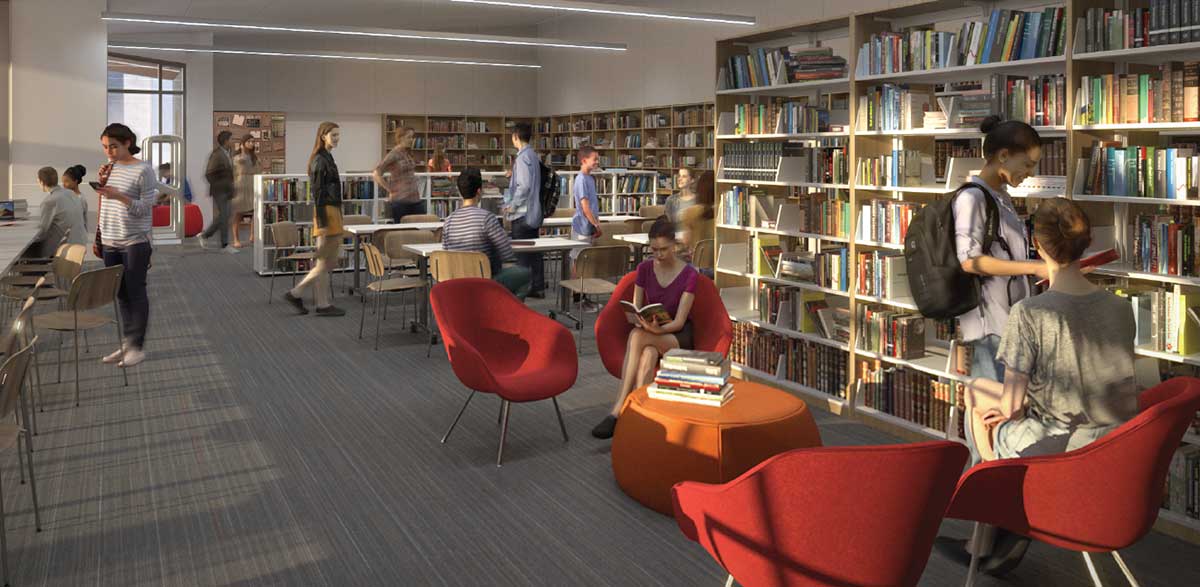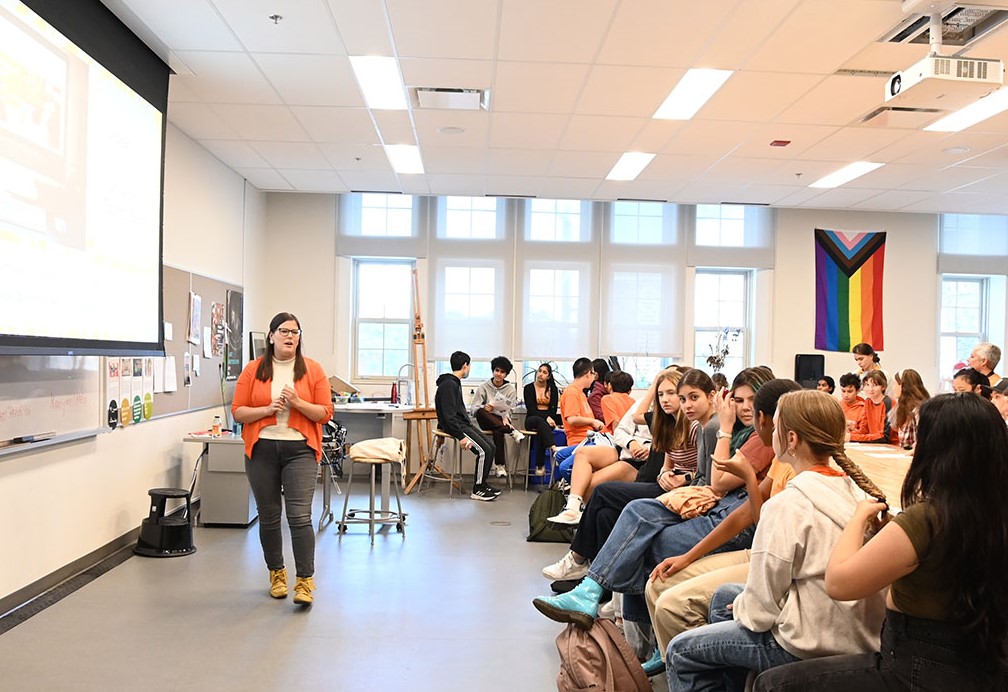371 Bloor Street West
Toronto, ON M5S 2R7 get directions
Toronto, ON M5S 2R7 get directions

Jesse Wente, chair of the Canada Council for the Arts, urged students to move beyond being allies of Indigenous peoples to become accomplices.
Two generations – that was how long Jesse Wente, Ojibwe broadcaster, Indigenous advocate and pop culture philosopher, says it took for his family to lose their Anishinaabe language and their culture because of residential schools. His grandmother went to the residential school in Spanish, Ontario, and the language was taken from her. Now he’s wondering, what if within two generations the languages and cultures could be restored to all Indigenous peoples in Canada?
“Let's set a goal for our country that my grandchildren will be fluent in the Anishinaabe language,” Jesse suggested in his keynote speech, Moving from Reconciliation to Right Relations, part of an entire school day of learning at UTS for the National Day for Truth and Reconciliation. “We think of everything as being taken in our cultures and our languages ‒ all of that can be given back. We could build schools for Indigenous Canadians that give the languages and cultures back, instead of those that take them away.”
He told students that they could help design the system to make that happen, and push the people in charge to do this. Jesse knows about making change; as the Chair of the Canada Council for the Arts, he is the first Indigenous Canadian to head a Crown corporation and was the first executive director of Canada’s Indigenous Screen Office. A Canadian media celebrity, he served as CBC Radio Metro Morning’s film and pop culture critic for 20 years and as TIFF Bell Lightbox’s Director of Film Programmes, as well as authoring the best-selling book, Unreconciled: Family, Truth, and Indigenous Resistance.
Visibility matters
Jesse was one of several Indigenous guests and allies who came to UTS on September 29 for the day of learning, which was planned by a committee of UTS students and staff. It was the second year in a row UTS dedicated an entire day to Truth and Reconciliation.
“Visibility is really important – the National Day for Truth and Reconciliation needs to be something people take note of,” said S6 (grade 12) student Nicola, a member of the Day’s organizing committee and an executive on the UTS Indigenous Solidarity Committee. “That is why we felt it was important to have a disruption of normal events, pressing pause on our very busy lives to reflect on the past and our responsibility to try and improve the relationships that we have between Indigenous people and ourselves. In the long run, focusing on these relationships will improve our lives, and our country as a whole.”
The opening assembly where Jesse spoke also included videotaped Survivor testimony from Louise Longclaws, who at age six was sent to Brandon Residential School for five years, and a performance by UTS Chamber Strings of Missing. The piece was composed in honour of missing and murdered Indigenous women and girls by Cris Derksen, an Indigenous cellist who is also the composer-in-residence at UTS for the 2023-24 school year.
Moving from understanding to action
“Understanding the issues of Truth and Reconciliation is only the first step,” UTS Principal Dr. Leanne Foster told students. “We have to move beyond just understanding, listening and talking. We cannot simply hear the stories of Survivors and not be prepared to give back. Action can be your gift.”
A large orange National Day for Truth and Reconciliation banner was displayed on the school’s Bloor Street facade and throughout the day, students had the opportunity to take workshops on the Kanyen'keha (Mohawk) and Anishinaabemowin (Ojibwe) languages, plant medicines and birds of Anishinaabe Aki, how to be treaty citizens, and the power of allyship.
Every bird has a story to share
Joseph Pitawanakwat (right), an Ojibwe from Wikwemikong First Nation, spoke to students about the birds and plants of Birds of Anishinaabe Aki in the plant medicines and birds workshop, which he led with his associates.
“When we're outside and looking into the natural world, we're looking at everything that is out there and we're trying to understand them,” Joseph Pitawanakwat told students in the plant medicines and birds workshop, which he led with his associates. “Our idea is that every plant, every bird, every bug, every mineral has a story to share. And we have the responsibility to listen.” An Ojibwe from Wikwemikong First Nation on Manitoulin Island, Joseph founded the Creators Garden, an Indigenous education-based business.
One cultural aspect Joseph shared is that birds who have red eyes can teach us something about mourning, about grief, sadness and how to be emotionally intelligent throughout hard times. For example, Joseph says the loon – maang in Ojibwe – displays on its back a constellation map of the stars, a map for the journey for where people go when they die, and for their loved ones to support them through that process.
Lessons in language

Kristi Talbot talks UTS students through some introductory phrases in the Kanyen'keha (Mohawk) language.
Kristi Talbot, a registered early childhood educator with over a decade of experience serving her Indigenous community in Fort Erie, Ontario, talked students through some introductory phrases in the Kanyen'keha (Mohawk) language, while also sharing her personal history with the students.
“I have a family history of residential schooling with my grandparents,” Kristi says, “and that impacted the generations following – how the cycle of abuse came into play within my family and how that had to be broken, which resulted in us being very removed from our community.”
She says it had been a couple of generations since her family has lived on an Indigenous reserve or community. “It wasn't until I was 15, that I even began to reconnect, starting my journey working with children and with language ‒ and it was that connection that brought me back to my culture and to where I am today.”
Throughout the day, UTS students also took part in discussion circles about how we can move towards right relations, sharing their reflections and also ideas about how actions they can take.
Canada’s Chemical Valley
Vanessa Gray, a queer Anishinaabe kwe, grassroots organizer, land defender and educator discussed the environmental racism her community, the Aamjiwnaang First Nation, faces in Canada’s Chemical Valley near Sarnia.
In the closing assembly, Vanessa Gray, a queer Anishinaabe kwe, grassroots organizer, land defender and educator shared her story of how she continues to use Toxic Tours as an educational tool to bring awareness to the environmental and racial violence upheld by colonial structures such as Canada. The Toxic Tours show the pollution faced by her community, Aamjiwnaang First Nation, in Canada’s Chemical Valley near Sarnia which has 40 percent of our country’s petrochemical industry ‒ over 60 facilities in a 25-kilometre radius.
Now Vanessa is the Co-Director of the Environmental Data Justice Lab at University of Toronto’s Technoscience Research Unit. In 2019, she led the U of T project to develop the Pollution Reporter app, which allows people in the Aamjiwnaang to report their symptoms in real time and send the information by email to the provincial environment ministry.
“Before we had this app, I would watch on Facebook as many community members were saying things like everyone in my household is having nosebleeds or headaches or all the kindergarten kids have red eyes,” Vanessa told UTS students.
Now they have centralized data tracking, and she plans to expand the app to become a national resource for Indigenous communities across the country. She also recently co-authored the report, Data Colonialism in Canada’s Chemical Valley: Aamjiwnaang First Nation and the Failure of the Pollution Notification System, created in partnership between the Yellowhead Institute and the Technoscience Research Unit.
“This is ongoing in the Great Lakes and an issue that we all should be paying attention to…” said Vanessa. “…There are things to be done. It's not always fun and it's a lot of work, but that gives me peace of mind to actually do something with my time instead of just worrying about the future.”
Reconciliation for the land
At the start of the day, Jesse said that “Indigenous peoples are already post-apocalyptic. We've lived through the end of our world. I don't think we fear the apocalypse in the same way other people and countries do.”
The greatest Reconciliation that lies ahead of us is actually not amongst ourselves but a larger Reconciliation to the land. “I think we're increasingly understanding why we will have to reconcile that connection,” he said. “For Anishinaabe, the land is our kin, meaning it’s like our brothers, sisters and mothers.”
Beyond allies to accomplices
Waiting to learn everything is not essential before Reconciliation begins, Jesse added. “While you’re learning, do things beyond the intellectual, such as joining a protest or going to a pow-wow, which are open to everyone. Go beyond being allies of Indigenous peoples to accomplices where you do things together. Wearing an orange shirt seems like such a small thing, but seeing people wearing our shirt is actually very meaningful.”
The day closed with remarks from Andrew McConnell, who advises UTS staff and teachers on Indigenous issues and urged students to help lead the way towards Reconciliation.
“Any one of you can lead ‒ all you have to do is choose a direction and go that way and others will see the good that you're doing,” said Andrew, who is also a course director at York University’s Faculty of Education, on secondment from the York Region District School Board. “You may feel overwhelmed now, but look around and see who is doing good work and how you can work with them. At the moment you know what to do, then you too can lead.”

Rebecca Levere, a UTS Canadian and World Studies teacher, leads one of the discussion circles about moving towards right relations with Canada’s Indigenous peoples.